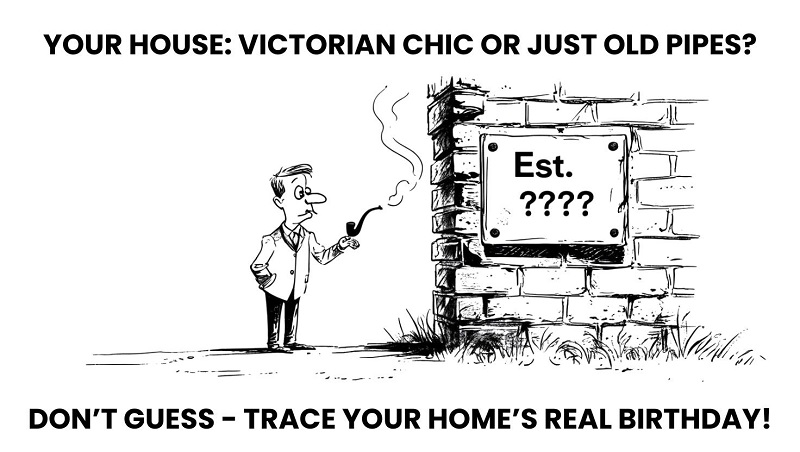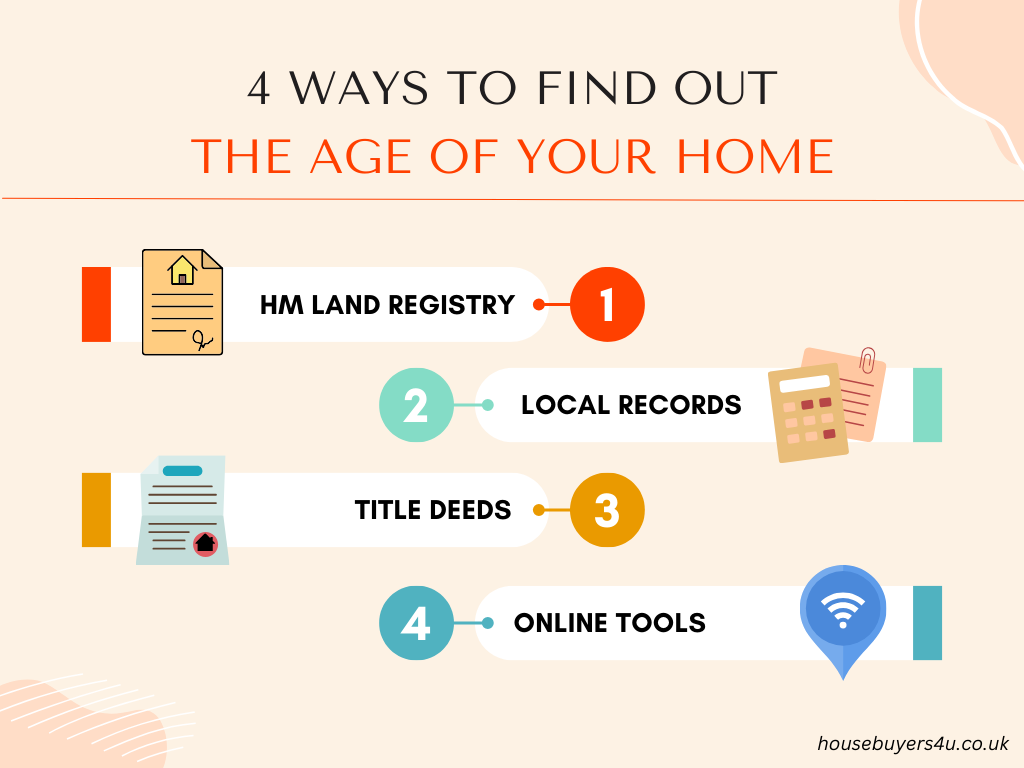How Old is My House & When Was It Built?

Updated: July 2025
To find out how old your house is or when it was built, check your title deeds or HM Land Registry records for the construction date, and use local council archives, architectural features, or historical maps for extra detail. Combining online records with offline clues gives you the most accurate picture of your home’s history.
Key Takeaways
- HM Land Registry and local council records are the quickest ways to check your house’s age.
- Offline sources like maps and archives can reveal extra details not found online.
- Knowing your home’s age helps with property value, renovation, and insurance decisions.
How Old is My House?
You can find out how old your house is by checking your HM Land Registry records, title deeds, or local council archives, which often show the original construction date. If those aren’t available, look for clues in your home’s architectural features, window styles, or brickwork, and consult historical maps or local libraries for supporting evidence.
How to Find Out When your House was Built
There are several ways to check the age of your home online. Here are some of them:
1) HM Land Registry
The HM Land Registry is a government database that serves as a comprehensive repository of property records for homeowners in England and Wales. It offers a historical snapshot of land ownership.
-
Access HM Land Registry: Visit the HM Land Registry's official website.
-
Search for your property: Input your property's specific address or, if known, the title number.
-
Get the Title Register: Download a copy of the Title Register. It is a document that lists the properties that were built and subsequently sold post-1862.
2) Local Authority Records
Local authority records can also help homeowners and researchers in the UK. Each council maintains a repository of records and documents containing key information about properties within their jurisdiction.
-
Contact the local council: Reach out to the planning or building control departments.
-
Request the information: This might include a historical planning permission and building control record.
3) Title Deeds
Title deeds hold key information about the history and age of a property.
-
Get the Title Deeds: Contact your mortgage provider or solicitor to request access to these documents.
-
Analyse the Deeds: Look for the date of the first transfer or sale of the property. This is often a strong indicator of the property's age, especially if it relates to known periods of development in the area.
4) Other Online Resources & Tools
These offer an accessible and often free way for homeowners to identify the age of their homes.
-
Historical maps like Old Maps UK
-
Property information websites
-
Building age estimators
-
Local government online archives
Finding Out How Old Your House is Using Offline Methods
-
Local History Societies: Offer access to records, maps, and knowledge of local building styles that help date your home.
-
Architectural Surveys: Experts can identify your house’s age by analysing features like brickwork, roofing, and mouldings.
-
Local Libraries and Archives: Hold building plans, maps, and historical documents that may reveal when your property was built.
-
Other Methods: Ask neighbours, community members, or previous owners for insights or stories about your home’s history.
Using Architectural Features to Identify House Age
Key architectural features can help you identify the period when your house was built. Note that some of them may overlap.
| Period | Years | Main Materials | Key Features |
|---|---|---|---|
| Tudor | 1485–1603 | Timber, brick | Half-timbered, steep roofs, ornate chimneys, small windows, upper floors overhanging, decorative woodwork |
| Elizabethan | 1550–1625 | Timber frame | Mullioned windows, elaborate decoration |
| Jacobean | 1603–1625 | Timber, brick, stone | Larger Gothic windows, plain exteriors, steep roofs, decorative chimneys, wide fireplaces |
| Queen Anne | 1702–1714 | Brick, stone | Large sash windows, curved gables, symmetry, restrained elegance |
| Georgian | 1714–1837 | Brick, stone | Central door with fanlight, ornate fireplaces, classical proportions, symmetry |
| Regency | 1811–1820 | Brick, stone, stucco | Stucco facades, large windows, refined and elegant style |
| Victorian | 1837–1901 | Brick | Bay windows, high ceilings, sloping roofs, red/coloured brick, ornate porches, stained glass, detailed interiors |
| Edwardian | 1901–1910 | Brick, timber | Wide halls, windows front and back, hipped roofs, dormer windows, simple style |
| Post WWI | 1918–1940 | Brick, steel, pebbledash | Flat or sloping roofs, large bay windows, semi-detached or terraced, open-plan spaces, clean lines |
Special Cases: Councils Homes & Listed Buildings
The process of determining the age of council homes and listed buildings differs from that of residential properties.
How to Check the Age of Council Houses
To find out when your council house was built, contact your local housing authority. They keep records of all council properties and their construction dates. Local archives or county records often hold information about major public housing developments, especially post-war estates. Looking up the estate name or street in old planning documents can also reveal the build period.
Related: Can I buy my council house?
How to Check the Age of Listed Buildings
For listed buildings, start with the National Heritage List for England (NHLE), which gives detailed information on the age, architectural style, and reason for listing. Local conservation offices and historical societies may have additional records about the building’s history, alterations, and any restoration work. An architectural historian can also provide an expert opinion if records are unclear.
Why Knowing Your House's Age is Important
We’ve seen how knowing a property’s age helps homeowners make informed decisions. Older homes can offer charm and value, but they often come with challenges such as higher maintenance. In our experience, addressing age-related issues early can boost appeal and maximise value when selling.
| Reason | Why It Matters |
|---|---|
| Property Value | Older homes can be more valuable or unique, but age can also affect resale potential. |
| Renovation Plans | Knowing the era helps plan repairs, choose materials, and avoid costly mistakes. |
| Insurance Costs | Insurers may charge more or need extra details for older or period properties. |
| History & Character | The age gives insight into your home’s story and may boost appeal for certain buyers. |
HB4u Home Age Impact Survey (2024-2025)
How knowing a property’s age affected real outcomes for UK sellers (based on 400+ housebuyers4u cases)
| Scenario | % of Sellers Reporting Impact | Most Common Outcome |
|---|---|---|
| Age boosted perceived value | 31% | Higher offers due to “period charm” |
| Age revealed costly renovations | 24% | Renegotiation or lower offers |
| Insurance costs increased by age | 18% | Delay/extra steps in sales process |
| Unique history aided sale | 27% | Faster sale to “character buyers” |
| Buyers requested era-specific survey | 15% | Sale delayed for extra checks |
Advice from our Property Expert Paul:
"In my experience, knowing how old your house is can make all the difference when you’re making big decisions. I’ve seen sellers boost their home’s value just by highlighting its unique history, and I’ve seen buyers avoid costly renovation surprises because they understood the era their property was built in. If you’re thinking of selling, renovating, or even updating your insurance, it always pays to know your home’s true age."
Make the Most of Your Home’s History
Ready to turn your property’s story into a real advantage?
At Housebuyers4u, we value every detail, age, character, and unique features so you receive a fair and accurate offer with zero hassle.
Get your free, survey-backed quote today and discover how easy it can be to sell your home.

